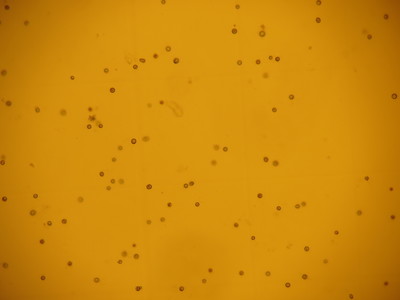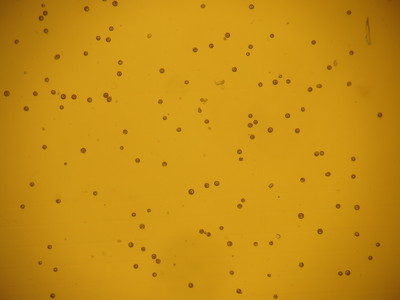Light intensity changes and UVB radiation affect peridinin content and antioxidant activity in the Cassiopea andromeda holobiont.
Kuehnhold, Holger, Schreiner, Monika, Kunzmann, Andreas  ORCID: https://orcid.org/0000-0002-9500-4332 and Springer, Karin
(2023)
Light intensity changes and UVB radiation affect peridinin content and antioxidant activity in the Cassiopea andromeda holobiont.
Frontiers in Marine Science, 10
.
DOI https://doi.org/10.3389/fmars.2023.1048346.
ORCID: https://orcid.org/0000-0002-9500-4332 and Springer, Karin
(2023)
Light intensity changes and UVB radiation affect peridinin content and antioxidant activity in the Cassiopea andromeda holobiont.
Frontiers in Marine Science, 10
.
DOI https://doi.org/10.3389/fmars.2023.1048346.
|
Text
Kühnhold et al. 2023 light UV peridinin AOA jellyfish Cassiopea.pdf - Published Version Available under License Creative Commons: Attribution 4.0. Download (1MB) |
||
![[img]](http://cris.leibniz-zmt.de/5190/2.hassmallThumbnailVersion/Image_1_Light%20intensity%20changes%20and%20UVB%20radiation%20affect%20peridinin%20content%20and%20antioxidant%20activity%20in%20the%20Cassiopea%20andromeda%20holobiont.jpeg)
|
Image
Image_1_Light intensity changes and UVB radiation affect peridinin content and antioxidant activity in the Cassiopea andromeda holobiont.jpeg - Supplemental Material Available under License Creative Commons: Attribution 4.0. Download (1MB) | Preview |
|
![[img]](http://cris.leibniz-zmt.de/5190/3.hassmallThumbnailVersion/Image_2_Light%20intensity%20changes%20and%20UVB%20radiation%20affect%20peridinin%20content%20and%20antioxidant%20activity%20in%20the%20Cassiopea%20andromeda%20holobiont.jpeg)
|
Image
Image_2_Light intensity changes and UVB radiation affect peridinin content and antioxidant activity in the Cassiopea andromeda holobiont.jpeg - Supplemental Material Available under License Creative Commons: Attribution 4.0. Download (1MB) | Preview |
Abstract
Introduction: The up-side down jellyfish Cassiopea andromeda represents a yet untapped marine species that could be targeted as a new source for functional ingredients, such as natural pigments and antioxidants. Since C. andromeda hosts endosymbiotic dinoflagellates, this jellyfish contains peridinin pigments, which are linked with high antioxidant capacities and many other health-promoting properties. This study investigates the potential to specifically increase the content of peridinin and overall antioxidant activity in C. andromeda, through the targeted application of different photosynthetic active radiation (PAR) intensities and ultraviolet radiation, cultured in fully controlled indoor aquaculture systems.
Materials and Methods: Indoor bred C. andromeda specimens were exposed to five different PAR intensities (50, 100, 200, 400 and 800 µmol photons m−2 s−1) and a combined treatment of narrow-band UVB (λ = 285 ± 10 nm) radiation and intermediate (200 µmol photons m−2 s−1) PAR intensity over a period of four weeks. Before the treatment and after two- and four-week treatment intervals, pigment concentrations and antioxidant activity levels were measured using high-performance liquid chromatography (HPLC) and the Trolox Equivalent AntioxidantCapacity (TEAC) assay, respectively. In addition, relative growth rate, umbrella pulsation and photosynthetic efficiency (measured by pulse amplitude modulated fluorometry) of C. andromeda individuals were also monitored throughout the experiment.
Results: Chlorophyll a (Chl a) and peridinin (Per) dominated overall pigment content in C. andromeda endosymbionts, chlorophyll c2 and diadinoxanthin were detected in minor amounts. Over the treatment time, Chl a and Per concentrations, measured as µg g−1 jellyfish dry weight and pg microalgae-cell−1, decreased sharply at higher PAR intensities (200 – 800 µmol photons m−2 s−1) compared to the control treatment (100 µmol photons m−2 s−1). After four weeks Chl a and Per concentrations were lowest at the highest PAR intensity (800 µmol photons m−2 s−1) and highest at the lowest PAR intensity (50 µmol photons m−2 s−1). Moreover, the ratio of Chl a and Per showed a relative decrease of Per with increasing PAR intensity. The combined treatment of narrow-band UVB (λ = 285 ± 10 nm) radiation and intermediate (200 µmol photons m−2 s−1) PAR intensity led to significantly elevated Chl a and Per concentrations compared to the 200 µmol photons m−2 s−1 PAR treatment without UVB. Significantly elevated antioxidant activity levels, measured as Trolox Equivalents mmol g−1 jellyfish dry weight, were only detected in UVB exposed C. andromeda, indicating that Chl a and Per did not determine overall antioxidant capacity. The photosynthetic efficiency of C. andromeda endosymbionts was not affected by elevated antioxidant activity. Opposing that, the jellyfish hosts that were exposed to the UVB treatment shrunk drastically, indicating a strong stress response.
Discussion: With this study, we demonstrate for the first time the application potential of PAR intensity manipulations and UVB irradiation, to increase the content of valuable pigments and antioxidants in C. andromeda jellyfish and their endosymbiotic dinoflagellates that live in hospite within the host tissue. Based on these findings, we propose the culture of C. andromeda under fully controlled and light-optimized conditions as new pathway to harness bioproducts and functional ingredients.
| Document Type: | Article |
|---|---|
| Programme Area: | PA1 |
| Research affiliation: | Ecology > Experimental Aquaculture |
| Refereed: | Yes |
| Open Access Journal?: | Yes |
| DOI: | https://doi.org/10.3389/fmars.2023.1048346 |
| ISSN: | 2296-7745 |
| Date Deposited: | 24 May 2023 07:34 |
| Last Modified: | 24 May 2023 07:34 |
| URI: | https://cris.leibniz-zmt.de/id/eprint/5190 |
Actions (login required)
 |
View Item |





 Tools
Tools Tools
Tools

